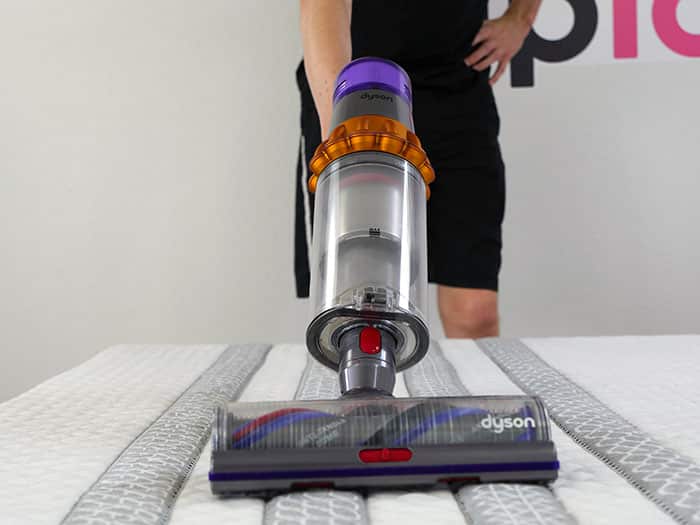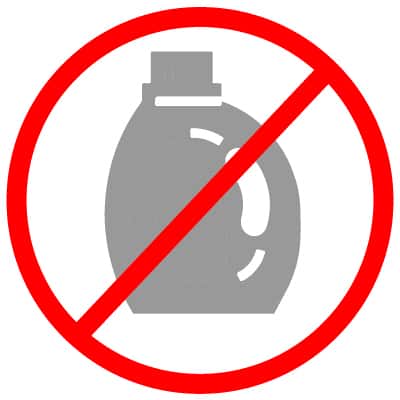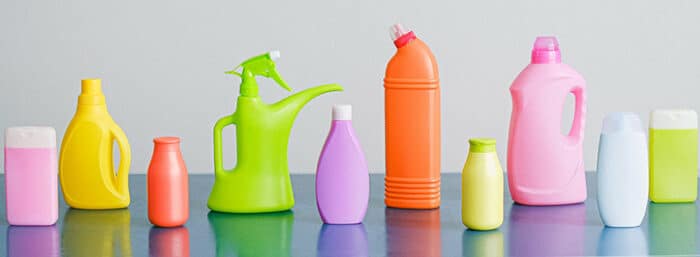Mattresses are home to dust mites, bacteria, fungi, and other germs, warns the American Council on Science and Health.
They also tend to attract dust, dead skin, and pet dander. Even if you use a mattress topper and wash your sheets regularly, bacteria can still build up in your mattress.

Despite these risks, few people know how to clean a mattress properly. While it’s true that some materials, such as memory foam, require special care, the cleaning process is fairly simple.
All you need is a vacuum cleaner and basic products like baking soda, dish detergent, and white vinegar.
Generally, it’s recommended to clean your mattress every six months or so. Follow the steps below to make sure you do it right.
What is the best thing to clean your mattress with?
First, make a list of cleaning supplies. These may include:
- Baking soda
- White vinegar
- Liquid dish detergent
- Enzymatic cleaners
- Table salt
- Hydrogen peroxide
- Spray bottles and bowls
- Essential oils (optional)
Note that you may not need everything on this list.
Table salt, for instance, should only be used if your mattress has blood stains. Simply mix it with cold water, apply it to the stain, and clean the area with a slightly damp cloth after a few minutes. For other options, see our guide on how to remove blood stains from a mattress.
If you’re dealing with wine, vomit, or urine stains, you may need an enzymatic cleaner. Powdered laundry detergent may work, too.
#1. Take off all bedding.
Remove the mattress topper, bed sheets, pillowcases, and other bedding items. When you’re done, you should have a bare mattress in front of you. Place your bedding in a laundry basket and wash them as soon as you can.
Meanwhile, check the care label attached to your mattress. Make sure it’s safe to use the cleaning products on your list.
Memory foam mattresses, for instance, should be handled with care. Using too much water can cause mold growth and damage the fabric. As a general rule, avoid bleach and harsh detergents.
#2. Vacuum your mattress.
Next, vacuum your mattress to get rid of dust, debris, and pet dander. This is something you can do every couple of weeks, not just when cleaning the mattress.
Dust and dust mites can trigger or worsen asthma and allergies. Some people are allergic to dust mites without even realizing it.

Common symptoms include coughing or sneezing, itchy skin, red eyes, stuffy nose, and excess mucus in the throat and back of the nose.
Regularly vacuuming your mattress may help reduce these symptoms. Here’s how to do it right:
- Use a clean vacuum upholstery attachment to remove dust and debris from the surface, bottom, and sides of the mattress.
- If your vacuum cleaner has a crevice tool, use it to remove the dust from around its edges and quilting layers.
- Make sure you also vacuum the area between the box springs and the mattress.
- Open the windows to let fresh air in.
Another option is to steam clean and vacuum the mattress. First, you’ll use a garment steamer to kill dust mites and then vacuum the entire area.
Can you clean your mattress with vinegar?
If your mattress has no stains, you may use white vinegar or baking soda to freshen it up after vacuuming. This step is optional, but it can help remove odors and eliminate moisture.
Cleaning a mattress with vinegar
Spray a small amount of white vinegar over the mattress to get rid of persistent odors. Use a paper towel to remove excess moisture. Let it dry and then apply baking soda.

Cleaning a mattress with baking soda
Sprinkle a layer of baking soda over your mattress and rub it gently with your hands. Mix the baking soda with a few drops of essential oil if desired. Leave it for 30 minutes or longer and then vacuum the mattress again.
NOTE: Don’t use both products at the same time, as they will cancel each other out.
How to Sanitize A Mattress
Cleaning, disinfecting, and sanitizing are not the same thing. While cleaning your mattress is important, you may also want to sanitize and disinfect it to kill germs.
If you buy a used mattress, sanitize it immediately. Even if your mattress looks clean, you should still disinfect it to freshen it up and reduce bacteria.
Avoid harsh chemicals and consider using a natural disinfectant, such as:
- Distilled white vinegar and essential oils (e.g.: clove, rosemary, or eucalyptus oil)
- Vodka/rubbing alcohol (1 1/2 cups), white vinegar (1/2 cup), and essential oils, as recommended by Live Simply
- Vodka (pour it into a spray bottle and apply a small amount over the mattress)

Next, follow these steps to disinfect and sanitize your mattress:
- Remove your mattress from the bed and place it next to a wall.
- Spray the surface of the mattress. Repeat on the other side.
- Let it dry for a few hours. Use a fan or blow dryer to speed things up.
Only apply a small amount of vodka, vinegar, or whatever products you’re using. The surface of the mattress should be slightly damp, not wet. Use a clean, dry cloth to remove excess moisture.
How to Deep Clean Your Mattress
Check your mattress for stains while vacuuming it. If you see any, spot-clean the mattress before you deodorize it. Consider the type of stain and the material your mattress is made of.

Sweat, urine, vomit, and the oils coming from your skin or hair can all leave yellow stains behind. The same goes for mold and mildew, which may create excessive moisture and cause yellow spots on the mattress.
These stains are often the hardest to remove. Our advice is to use natural cleaning solutions rather than detergents, but you may need an enzymatic cleaner for stubborn stains.
Enzymatic cleaners not break down stains, but also eliminate odors. As the name suggests, these products contain enzymes that digest fats, protein, and more. If you decide to go this route, choose an organic or plant-based enzyme cleaner.
Another option is to use common household products to get yellow stains out of your mattress. Let’s see a few examples:
- Distilled white vinegar
- Hydrogen peroxide
- Baking soda
- Table salt and lemon juice
- Ammonia
- Liquid dish soap
Hunker recommends a mixture of baking soda, salt, and water. Combine all ingredients in a small bowl and rub the paste onto the stain. Let it dry and then remove it with a damp cloth.
Likewise, you may use dish soap and baking soda or hydrogen peroxide. Gently rub the mixture onto the stain and leave it for up to 30 minutes before cleaning the area.
Some of these cleaning solutions will work for other types of stains, too.
For example, you may use white vinegar and hydrogen peroxide to get wet urine stains out of your mattress. See our guide to mattress stain removal to learn more.
How to Clean a Mattress Fast
Depending on the overall condition of your mattress, cleaning it can take hours. However, you may be able to do it faster— especially if the mattress is stain-free.
When you’re in a rush, take these steps to clean and deodorize your mattress quickly:
- Mix 1/2 cup of baking soda and 20 drops of essential oil into a bowl.
- Sprinkle the solution onto your mattress.
- Vacuum the mattress after half an hour or so.
- Spray an air freshener onto it.
- Open the windows or use a fan to air-dry the mattress before putting on the sheets.

The entire process should take about 30 minutes, says Well and Good. While it’s not as effective as deep cleaning, it may help prevent and remove bad odors.
If you don’t feel comfortable using commercial air fresheners, you can always make one at home. For starters, try this natural air freshener recipe from Southern Living:
Homemade Air Freshener Ingredients
- 2 cups of water
- 2 tablespoons of baking soda
- Lavender, eucalyptus, or lemon essential oil (20 to 30 drops)
Directions
- Mix the baking soda and essential oil into a medium bowl.
- Add two cups of water and stir well.
- Pour the mixture into a spray bottle and shake it.
How to Clean a Memory Foam Mattress
As mentioned earlier, memory foam is trickier to clean. Here are some things to keep in mind:

#1. Never use a steam cleaner.
Steaming a mattress may cause excess moisture. However, it’s perfectly safe to vacuum a memory foam mattress.

#2. Avoid using harsh detergents and cleaners.
Hydrogen peroxide may cause problems, too. These products can damage the foam. Instead, use a homemade cleaning solution of mild detergent and water to remove stains.

#3. Don’t rub. Blot instead.
If you’re dealing with stubborn stains, apply a mixture of white vinegar and water. Refrain from rubbing too hard. Use a damp rag to remove to clean the area.

#4. Dry the mattress quickly.
Getting a mattress dry (fast!) helps to prevent moisture from seeping through. Ideally, let it dry in direct sunlight or use a hairdryer at a low setting to speed things up.
Still not sure you’re up for the task? If you’re unsure of the process or not getting the results you want, consider reaching out to a professional cleaning company.
Especially for tough stains, pros may have better results and have a few secret tricks of the trade up their sleeves. The DIY cleaning methods described above may not work for every type of stain and fabric.
Keep Your Mattress Clean Year-Round
Now that you know how to clean a mattress, get the right tools for the job and keep them on hand. Double-check the care label, look for stains and spills, and then decide what products you want to use.

Our advice is to use a waterproof mattress cover and a fitted sheet. This will not only protect the mattress from dust and spills but also make cleaning easier. Take one step further and clean your bed before vacuuming and deodorizing the mattress.



